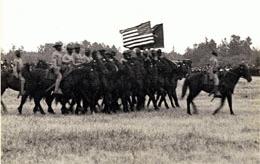On July 1, 1904, troops from the U.S. Army and the Washington and Oregon National Guard hold large-scale maneuvers at American Lake, south of Tacoma. The exercise is a success and will lead the Army to select the area for Camp Lewis, later Fort Lewis, in 1917.
The Beginning: Camp Ferry
On November 11, 1889, Washington Territory became the 42nd state of the union. During the first session of the State Legislature in Olympia, a tax was enacted to establish a Military Department of Washington. The citizens of the new state were aware of the importance of a well-organized and trained militia to respond to natural disasters as well as to civil disturbance and war.
In June 1890, Rossell G. O'Brien, an adjutant general in the Washington National Guard and future mayor of Olympia, conducted a Brigade Encampment at American Lake in Pierce County. Organized into two regiments of infantry and a battalion of cavalry, 1,155 militiamen participated in the encampment, which was named "Camp Ferry" after the incumbent governor, Elisha P. Ferry (1825-1895). The total cost of the encampment, including the payroll, was $20,319.20.
Following on the success of the first brigade encampment, other encampments were held in 1892, 1894, and 1902. In 1903, the state of Washington purchased 220 acres of land at Murray, on the Tacoma-Olympia-Grays Harbor Railroad line. Named after a local pioneer family, Camp Murray remains to this day the headquarters of the Washington State Military Department.
American Lake Maneuvers
In 1903, Congress approved, "An Act to Promote the Efficiency of the Militia." The act provided for joint maneuvers between the organized militia and the Regular Army. The American Lake area was selected as the site of the first joint maneuvers involving the Washington National Guard. The maneuvers were scheduled for July 8 to July 17, 1904.
In May 1904, General Frederick Funston made a reconnaissance of the area and decided to establish three camps. The Blue Force was located at Camp Steilacoom near the north end of Lake Steilacoom. The Brown Force was based at Camp Nisqually on Sequallitchew Creek. The site was close to the old Hudson's Bay trading post. The Maneuver Division Headquarters was established at Murray Station on the Olympia branch of the Northern Pacific Railroad. The headquarters had telegraphic connection with both camps. When General Arthur MacArthur, Commander of the Division of the Pacific, arrived to observe the maneuvers, a submarine cable was laid across American Lake to the general's residence at the Nolan House on the lake's north shore.
During the month of June regular Army officers arrived at American Lake to set up the camps and arrange for subsistence for the troops. They also drew up maps and formulated tactical problems and battle plans for the troops. The Blue Forces were designated the First Brigade and were commanded by Colonel Edward S. Godfrey of the 9th U.S. Cavalry.
The Blue Force
The units assigned to the Blue Force were:
- the 19th U.S. Infantry Regiment;
- 2nd Regiment, National Guard of Washington;
- Separate Battalion, Oregon National Guard;
- 26th Battery, U.S. Field Artillery;
- Troop F, 9th U.S. Cavalry;
- Troop A, Oregon National Guard;
- Troop B, National Guard of Washington;
- Brigade Hospital, Regimental Hospital, U.S. Army;
- Hospital Detachment, Washington National Guard, U.S. Army Signal Corps Detachment;
- Company A, Signal Corps, National Guard of Washington.
The Brown Force
The Brown Forces were designated the Second Brigade and were commanded by Colonel Charles H. Noble, 10th U.S. Infantry. Units of the Brown Forces were:
- 10th U.S. Infantry Regiment;
- 3rd Regiment, Oregon National Guard;
- 2nd Regiment, Idaho National Guard;
- 8th Battery, U.S. Army Field Artillery;
- Troops F & H, 9th U.S. Cavalry;
- Brigade Hospital;
- Hospital Corps Detachment, Oregon National Guard;
- Regimental Hospital, U.S. Army;
- U.S. Army Signal Corps Detachment.
The Maneuver Headquarters was commanded by General Frederick Funston and was guarded by Troop G, 9th U.S. Cavalry and Company K, 19th U.S. Infantry. The Band of the 9th U.S. Cavalry was also assigned to the headquarters.
Tactical Problems Reviewed
On July 8, 1904, all the troops were assembled and prepared for the first tactical problem to be conducted on the following day. The regular Army was represented by 102 officers and 1,585 soldiers. The organized militia had 170 officers and 2,154 men in attendance. Hence the entire "Maneuver Division" consisted of 272 officers and 3,739 soldiers. The total force of 4,011 men was the largest military contingent ever seen in Washington up to that time.
The maneuvers consisted of six different "Tactical Problems," which often involved separate exercises for the troops. Among the action were attacks and defense of camps, attacks on convoys, amphibious invasions, and raids. The maneuvers involved infantry, artillery, and cavalry actions and were supported by Signal Corps and Hospital Corps personnel. When the maneuvers concluded on Sunday, July 17, a grand review for Major General Arthur MacArthur was conducted by all the troops on a large field near Lakeview.
All in all, the 1904 Maneuvers were a great success and were important for convincing the United States Army on the suitability of locating a major military training area in the American Lake region. Other maneuvers were conducted in the same area in the years 1906, 1908, 1910 and 1912. The Army's interest in the region culminated with the establishment of Camp Lewis in 1917.

